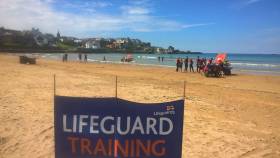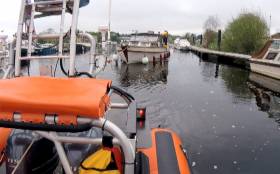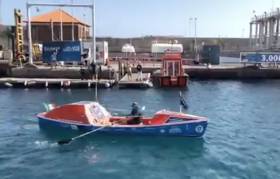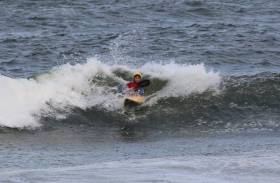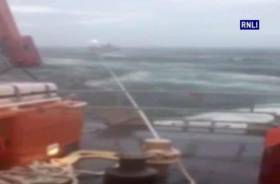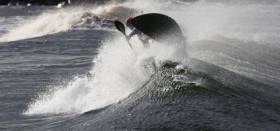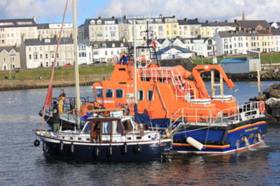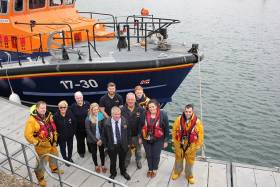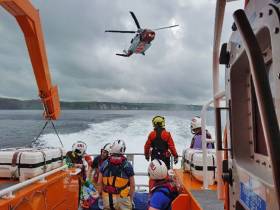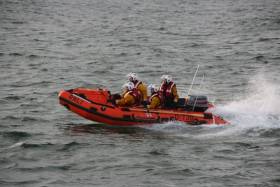Displaying items by tag: Portrush
#RNLI - RNLI lifeguards and the inshore lifeboat crew from Portrush RNLI rescued a swimmer who got into difficulty off Portrush East Strand on Wednesday evening (27 June).
The lifeguards who patrol the Causeway Coast beaches daily between 11am and 7pm were finishing up for the day when a member of the public raised the alarm.
The male swimmer had been seen entering the water 300-400m west of the patrol zone, towards Whiterocks, when he got into difficulty and was struggling to stay afloat.
Lifeguards Josh McCaw, Albert Dallas, Marcus McKeag and Nicola McIlroy immediately ran with their boards up the beach in the direction of the casualty.
Portrush RNLI’s inshore lifeboat helmed by Ben Wilson, was on exercise at the time when the crew spotted the lifeguards and immediately made their way to the scene.
The casualty was taken onboard the lifeboat and then transferred into the care of the lifeguards.
RNLI lifeguard supervisor Karl O’Neill said the situation could have been different minutes later. “Firstly, we would like to commend the member of the public who raised the alarm when they spotted someone in difficulty and we would like to wish the swimmer well after his ordeal.
“We want to remind everyone that while our lifeguards are busy patrolling our beaches daily, it is important to remember and adhere to our key safety advice both in and outside the patrol time of 11am-7pm.
“We were fortunate yesterday evening to be still on the beach when this incident happened and thankfully it resulted in a good outcome.
“We want to encourage people that when you plan a trip to the beach to check weather and tide times before you go and if planning to go into the water, to swim at a lifeguarded beach, between the red and yellow flags.
“We want everyone to enjoy this beautiful weather and to come to our beaches but we want everyone to do that with safety in mind knowing to always respect the water and to remain vigilant. If you get into trouble, stick your hand in the air and shout for help and if you see someone else in trouble, tell a lifeguard. If you can’t see a lifeguard, call 999 or 112 and ask for the coastguard.”
Elsewhere, Valentia RNLI volunteers launched their all-weather lifeboat yesterday afternoon (Thursday 28 June) to assist a 30ft motor cruiser with two people onboard, which had suffered mechanical failure.
At 2.37pm, Valentia Coast Guard requested Valentia RNLI's all-weather lifeboat to launch to the cruiser one mile south of Skellig Rock Little, Co Kerry. Weather conditions at the time were described as good with clear visibility.
Arriving on scene, a volunteer crew member was transferred to the casualty vessel to assist with setting up a tow, and the cruiser was towed safely back into Knightstown Harbour.
Speaking following the callout, Valentia RNLI volunteer lifeboat press officer Michelle Curran said: “With this stunning weather more people are taking to the water, we urge everyone to respect the water, always carry a means for calling for help and ensure all onboard know how to use it.”
#RNLI - Carrybridge RNLI’s inshore lifeboat launched yesterday morning (Sunday 6 May) following a request by Belfast Coastguard to assist a 37ft cruiser taking on water on the lough near Belturbet, Co Cavan.
The lifeboat Douglas Euan & Kay Richards, with helm Chris Cathcart, David Reid, Kyle Boyd and Colin Beacom on board, launched at 7.28am from Upper Lough Erne in Co Fermanagh and arrived shortly after in Belturbet.
Winds were southerly, Force 1 and visibility was good with sunny skies.
The lifeboat crew located the casualty vessel moored alongside the public jetty, but still taking on water. Belturbet Fire and Rescue Service were also in attendance. The owner and his dog were unharmed.
The RNLI volunteer crew set up their salvage pump, and started to pump the water out of the casualty vessel. Once the water level started to lower, the access point of the water was located and a temporary seal put in place.
The casualty vessel was then pumped out dry, and the lifeboat towed it to the public slipway where it was beached to avoid it sinking. The lifeboat departed the scene at 9.40am.
Following the callout, Cathcart said: “The crew were glad to be able to assist the owner this morning with his vessel, and hope he continues to have an enjoyable holiday.”
Much earlier on Sunday, the Portrush all-weather lifeboat crew in Co Antrim happened upon a casualty on land after a callout was stood down.
Three volunteer crew — Karl O’Neill, Jason Chambers and Ben Durrant — were returning home after the 1.40am call when they discovered a man who had fallen and had suffered significant injures to the face.
The crew dialled 999 to request assistance. O’Neill, who is also an RNLI lifeguard supervisor, had his responder bag to hand and was able to administer first aid to stop the bleeding from the casualty’s face. Durrant then took the casualty to the local emergency department for further treatment.
Keith Gilmore Portrush RNLI lifeboat operations manager, commented: “Once again our volunteer crew have shown that the skills and training they have received as lifeboat crew members can be applied to assist in any situation.
“I am very proud that the men on their way home at 2am stopped to help a member of the public who was obviously injured and in distress. We wish him a full recovery.”
Irish Crews Set off on Atlantic Rowing Race
#OceanRowing: Damian Browne has just set off to row the Atlantic. The former professional rugby player, in his boat Darien, left today from La Gomera in the Canary Islands to embark on the Atlantic Challenge race to Antigua. The fours, Relentless, from Cork and Dublin, and Home to Portrush, went off before solo oarsman Browne, who was the last of the 25 boats to leave today.
The start of the race had been delayed for two days because of high winds.
Irish Surf Kayaker Takes Junior Title At Portrush Worlds
#SurfKayaking - Ireland’s Jamie O’Brien placed first in the Junior IC class at the World Surf Kayaking Championships this past week on the Causeway Coast.
O’Brien also scored with a third in the Junior HP final ahead of fourth-placed Meabh Lynch, who represented Ulster at the contest held on Portrush’s East Strand from 20-28 October.
Brigitte Egan and Aisling Griffin were among the best of the Irish competing in the team finals, with Mike Barry, Matthew Lamont, Nathan Laplaud, James O’Donnell and Jamie Gamble also faring well in their team heats.
The Belfast Telegraph has video of some of the action from Portrush, while further results can be found at the official event website HERE.
Portrush RNLI in 15 hour Call Out to Rescue Six Fishermen From 15m Boat with Engine Failure (VIDEO)
Portrush RNLI has rescued six fishermen during what was a 15 hour call out for the volunteers in rough weather conditions after the fishing boat sustained engine failure off the Donegal coast.
The lifeboat crew was requested by Belfast Coastguard to launch their all-weather lifeboat at 10.37pm last night (Sunday 1 October) and go to the assistance of a 15m fishing vessel which had suffered engine failure approximately 10 miles north of Malin Head.
The all-weather lifeboat under Coxswain Mark Mitchell and with six crew members onboard, launched and made its way to the scene in stormy conditions. The weather was overcast with showers and moderate seas as the boat launched but conditions progressed to a force 8 south westerly gale as the lifeboat approached Malin Head.
The lifeboat arrived on scene at 0.45am and the crew assessed that the six fishermen were safe and well before working with them to establish a towline.
With a tow set up, the lifeboat proceeded to take the fishing vessel into Lough Swilly. However, with deteriorating weather conditions and with both the tide and wind against them, a decision was made to tow the boat into Greencastle.
During what was a slow tow, the lifeboat was assisted by Lough Swilly RNLI’s all-weather lifeboat which launched at 8am and assisted in bringing the fishing boat into Greencastle and putting the boat on its moorings.
The Portrush lifeboat crew arrived back at their station at approximately 1.15pm today.
Speaking following the call out, Keith Gilmore, Portrush RNLI Lifeboat Operations Manager said: ‘This has been a long and challenging call out for our volunteers in what were rough weather conditions but they were delighted to have been of assistance to the six fishermen who we would like to commend for doing the right thing and raising the alarm when their boat sustained engine failure. This call out is a fine example of volunteers showing their willingness to forgo a night’s sleep and the comfort of a warm bed and some food and using their skill and experience to face challenging weather conditions to help bring others to safety.’
#SurfKayaking - Glenties man Kieran McDyre won’t have too far to travel for the World Surf Kayaking Championships taking place in Portrush later this month.
This will be Dyre’s second time competing for Ireland at the event, according to the Donegal Democrat, and he’s already had opportunity to get the lay of the land — or the waves, as it were — on the Causeway Coast this weekend at surf kayaking’s NI Open.
More practice is on the horizon next Saturday (7 October) at the Irish Open in Sligo, where Dyre will compete against his teammates from the Irish squad preparing to challenge the world’s best in their craft.
As previously reported on Afloat.ie, Portrush’s East Strand is set to welcome 150 competitors from around the globe from 29-28 October.
Portrush Lifeboat Assists Cruiser In Difficulty
#RNLI - Portrush RNLI’s volunteer lifeboat crew got an early callout yesterday morning (Sunday 5 March) on reports of a cruiser with three on board that had got into difficulties 33 miles offshore just south-east of the island of Islay in Scotland’s Inner Hebrides.
Weather conditions were described as ‘perfect’ with a bright morning pagers went off at 10.10am, and the crew were quickly underway at full speed due the favourable sea conditions.
When the lifeboat crew reached the vessel, a towline was quickly attached to the cruiser and it was taken under tow to Portrush at a slow and steady rate of six knots. The lifeboat crew returned to base by 4.30pm, six hours after launch.
Portrush RNLI lifeboat operations manager Robin Cardwell said: “This was a textbook exercise for the crew, and something they train for all year round. The good weather conditions assisted the recovery and good progress was made for home.”
UK Justice Minister Visits Portrush RNLI Volunteers
Claire Sugden, The Justice Minister called in on her local RNLI Lifeboat station at Portrush the weekend to pay tribute to the work they do on the North Coast.
The Minister was keen to meet all the volunteers including crew, fundraisers and the operations team. She met Des Austin, Cox and Robin Cardwell Lifeboat Operations Manager (LOM) in the lifeboat House firstly to hear about the work of the volunteers and the rigorous training they underwent in order to achieve the competencies to be able to save lives at sea. She then met Sharman Finlay Chair of the fundraising team and Dorothy Weeks, supervisor of the very successful Lifeboat Shop to hear about the importance of fundraising activities to support the volunteer crew.
The Minister then met the volunteer crew of the Inshore Lifeboat and then went on board the All-weather Boat to get a tour of the boat and then experienced a launch as the crew took her out of the bay so she could see for herself, what the crew experienced when they went out on a shout.
The team at the station were delighted to meet the Minister and to have the chance to explain first-hand the importance of the work they do and the training that goes on behind the scenes.
Robin Cardwell LOM said
‘We were delighted to welcome the Minister to her local station and to give her an opportunity to see for herself the operations of a busy lifeboat station. We were thrilled that we had the opportunity to see the ALB in action to have a chat with the volunteer crew, operations team and fundraisers’.
The Minister said in a statement
‘The RNLI provides an invaluable service in keeping the public safe around our coastline. The men and women who volunteer to answer emergency calls in all weathers have helped save countless lives and I commend them for their dedication and commitment.
“The RNLI aims to reduce drowning by 50%, across the UK and Ireland by 2024. Given the dedication and enthusiasm I have seen demonstrated by the Portrush crew, I am confident that they will succeed.”
Cave Faller Rescue Caps Off Busy Week For Portrush Lifeboats & North Coast Lifeguards
#RNLI - It was another busy day for North Coast lifeboat volunteer crews as both Portrush RNLI lifeboats were launched for the second time in 24 hours yesterday evening (Sunday 24 July).
The all-weather and inshore lifeboats were launched at 5.30pm to reports of a casualty who had fallen onto rocks inside a cave just underneath Dunluce Castle.
Weather conditions were good with a calm sea and little wind which helped the lifeboats to reach the scene in good time. Rescue 999, the helicopter from Prestwick, was also tasked to airlift the casualty to hospital.
The Portrush inshore lifeboat (ILB), carrying a paramedic from the NI Ambulance Service, had to get as close to the shoreline as possible to recover the casualty.
Meanwhile, the all-weather boat (ALB) was waiting alongside to transfer the casualty so that the helicopter could carry out an airlift from the bigger boat.
"This operation took skill and precision and is something that lifeboat and rescue helicopter crews practice on a regular basis," said Portrush RNLI lifeboat operations manager Robin Cardwell.
"This was a textbook callout carried out with absolute precision by all involved. We hope that the casualty makes a full recovery."
Less than 24 hours previously on Saturday evening (23 July) both lifeboats were called out to reports of swimmers who were missing off the coast between Castlerock and Downhill.
Within minutes both lifeboats were on scene along with RNLI beach lifeguards on their rescue water craft. The Irish Coast Guard's Sligo-based helicopter Rescue 118 was also tasked.
The waters between the two land points were thoroughly searched with no swimmers being found. The search was stood down around 9.15pm and described as a ‘false alarm with good intent’.
Two other joint operations on the North Coast occurred earlier in the week, the first to reports of two surfers believed missing at Benone Strand on Tuesday (19 July).
Portrush's inshore lifeboat was requested by the lifeguards to assist in the search, though thankfully the surfers turned up safe and well.
The second callout on the same day around 4pm was to reports of a lost child at White Rocks beach. The coastguard and lifeguards searched the beach while the inshore lifeboat patrolled the sea just off shore. The child was found safe and well by the lifeguards.
More recently, the lifeguards themselves sprang into action on Saturday afternoon at Benone to assist a child who had been stung by a weever fish.
As part of their training the lifeguards undertake a comprehensive first aid course which equips them to deal with most situations they may encounter on a busy beach in the summer.
RNLI volunteer lifeguard press officer Liam Mullan reminded beachgoers to "always try to visit a RNLI lifeguarded beach. Remember to keep an eye on the flags and swim between the red and yellow flags.
"If you get into difficulty raise your hand and call for help. If you see someone in difficulty dial 999 and ask for the coastguard."
Portrush Lifeboat Launches To Swimmer In Difficulty
#RNLI - Portrush RNLI's inshore lifeboat launched yesterday evening (Tuesday 21 June) to reports of a swimmer in difficulty at the Herring Pond in Portstewart.
Three volunteer lifeboat crew launched the inshore lifeboat in cloudy conditions in a slight sea swell towards Portstewart, where they observed a young adult male not making progress in the sea.
The swimmer had got very tired and was spotted by an onlooker who raised the alarm.
Quickly arriving on scene, the lifeboat crew got the casualty on board and took him the short distance to Portstewart Harbour where they handed him into the care of the coastguard.
Portrush RNLI lifeboat operations manager Robin Cardwell said: "The onlooker did exactly the right thing. The RNLI would rather be called out if there is a danger of someone being in difficulty in the water. That’s what we are trained to do.
"The Respect The Water campaign highlights the dangers of the cold water and how quickly it is to get into difficulties."


























